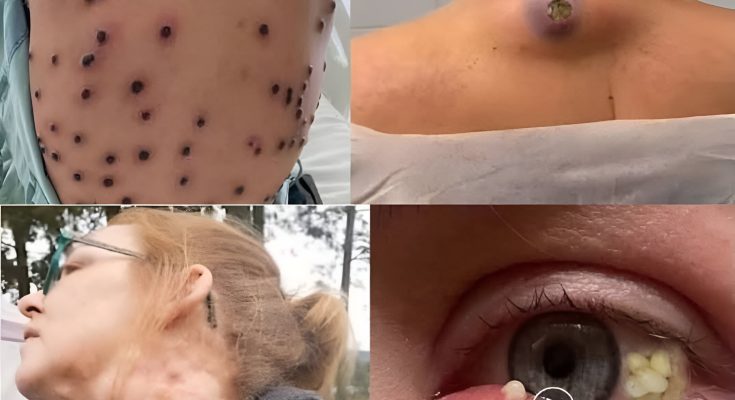Title: Understanding Severe Skin and Eye Infections: Causes, Symptoms, and Prevention
In today’s world, with advanced medicine and hygiene awareness, severe skin and eye infections still pose a significant health challenge across many regions. The images of individuals afflicted with numerous lesions, cysts, pustules, and eye infections are alarming, not only due to their visual impact but also because of the underlying medical issues they signify. These conditions, which may include severe acneiform eruptions, abscesses, parasitic infections, or contagious viral and bacterial diseases, can lead to complications if left untreated.
1. Skin Lesions and Nodules: Causes and Risks
The first image shows a back covered in numerous black-centered lesions. These could be indicative of several medical conditions:
-
Cutaneous infections such as staphylococcal or streptococcal infections, which often present with abscesses or pustules.
-
Acne fulminans, a rare and severe form of acne, can also manifest with widespread nodular lesions that become inflamed and infected.
-
In rare cases, such lesions could be linked to parasitic infestations or exposure to environmental toxins that trigger a dermatological reaction.
Skin lesions of this magnitude require immediate dermatological assessment, cultures, and possible biopsies to determine their exact cause.
2. Cysts and Abscesses: A Growing Health Concern
The second image, showing a pronounced cyst on the upper back, likely represents an abscess — a localized infection that causes a collection of pus under the skin. These can be caused by:
-
Bacterial infections, commonly Staphylococcus aureus, including MRSA strains.
-
Sebaceous cysts that become infected.
-
Inflammatory skin conditions, sometimes exacerbated by poor hygiene, immune suppression, or diabetes.
Such infections can escalate quickly and lead to cellulitis or systemic infections if not drained and treated with antibiotics.
3. Unusual Skin Growths and Possible Myiasis
The image of a woman with multiple open lesions on the neck, possibly showing fly larvae or maggots, suggests cutaneous myiasis — a parasitic condition caused by fly larvae that infest the skin. This condition is more common in tropical and subtropical areas and can occur when flies lay eggs in open wounds or on soiled clothing.
Symptoms include:
-
Pain, itching, and a sensation of movement under the skin.
-
Open sores that may secrete fluids or pus.
-
Secondary infections from poor hygiene or delayed treatment.
Myiasis requires prompt medical removal of larvae and thorough wound care, often followed by antibiotics to prevent further complications.
4. Severe Eye Infections: When to Worry
The final image depicts an infected eye with what appears to be pus accumulation and possibly a parasitic or bacterial presence. Such eye infections can be vision-threatening and are often associated with:
-
Conjunctivitis (bacterial or viral).
-
Hordeolum (stye) or chalazion, both of which are infections of the eyelid glands.
-
In rare but serious cases, ocular myiasis or severe keratitis can present with such symptoms.
Signs that an eye infection may be severe include:
-
Pus or thick discharge from the eye.
-
Swelling and redness of the eyelids.
-
Pain and sensitivity to light.
-
Blurred vision or vision loss.
Immediate attention from an ophthalmologist is critical to preserving vision and preventing spread to other tissues.
5. Prevention and General Recommendations
To prevent such severe skin and eye infections:
-
Maintain good personal hygiene.
-
Treat minor wounds promptly and properly.
-
Avoid exposure to unsanitary environments, especially in endemic areas.
-
Use insect repellent and protective clothing in tropical regions.
-
Never delay medical treatment if signs of infection emerge.
Conclusion
The conditions depicted in these images are extreme but serve as important reminders of how essential early diagnosis, treatment, and hygiene are in preventing severe infections. While some may be rare in developed nations, they are still prevalent in underserved communities, rural regions, and in populations with compromised immunity. Public awareness, proper medical care, and preventative measures can significantly reduce the burden of such diseases.


